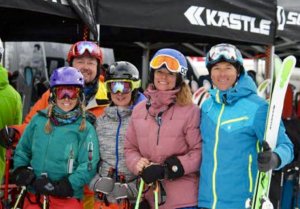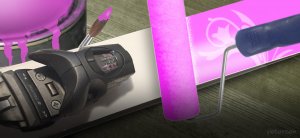So what is it that makes a woman’s ski, a woman's ski?
For some manufacturers, it is a complete change in build philosophy; for others, it is different graphics; for still others, it is that plus a forward mount point. Are any of these right or wrong? Since not all women are built the same, why should we expect their skis to be designed identically? Not all women even need women's skis, not all women have a lower center of gravity and need a forward mount point, and not all women ski differently. To assume so would be sexist. It still comes down to each skier's individual needs.
 Every season Tricia and our women testers get on 50 to 75 pairs of women's skis. Our three main female testers are small, medium, and tall; they are proficient skiers with different needs and desires in the ways that skis perform. SkiNurse at 4’13½” is lighter on her skis and can have a tough time demoing because her size is often unavailable; such sizes need the most refinement and tweaking in order to scale the core and flex for lighter skiers, so they are usually the last to get produced. SBrown, at 5'9" our tallest tester, can run into a similar (but opposite) problem because the longest length in the women's models is also often unavailable. At least she can test the skis that are unisex in construction because the only difference is the topsheet. Tricia is the reference size for the typical woman skier: 5’6” and perfectly built, she gets to try most everything.
Every season Tricia and our women testers get on 50 to 75 pairs of women's skis. Our three main female testers are small, medium, and tall; they are proficient skiers with different needs and desires in the ways that skis perform. SkiNurse at 4’13½” is lighter on her skis and can have a tough time demoing because her size is often unavailable; such sizes need the most refinement and tweaking in order to scale the core and flex for lighter skiers, so they are usually the last to get produced. SBrown, at 5'9" our tallest tester, can run into a similar (but opposite) problem because the longest length in the women's models is also often unavailable. At least she can test the skis that are unisex in construction because the only difference is the topsheet. Tricia is the reference size for the typical woman skier: 5’6” and perfectly built, she gets to try most everything.
Now, what are the differences between women's skis and what should you look for? First, some skis have no male counterpart, such as the Head Joy collection, which was designed from the ground up for women. These light and nimble skis not only have their own constructions, but they also have their own molds that Head uses nowhere else.
Armada does a very good job in scaling its skis to make sure all skiers have the same experience; this goes for both men and women. For example, the women's Victas are the same as the men's Invictus skis. Even though the model numbers differ, the Victa 83 is the same as the Invictus 85, the 87Ti is the same as the 89Ti, and the 93 is the same as the 95. The names change because Armada uses a shorter length for the women's skis as a reference size than the men's offering.
K2 was one of the first manufacturers to heavily promote women's skis way back when with the LTP in the 1980s, the T9 series around the turn of the century, and eventually the Luv collection (twice), which many feel is the reference series of the ski industry. The current Luvs share molds with their unisex brothers, the Iconics and Pinnacles, but their constructions are significantly different.
Rossignol's freeride skis are basically the same except for graphics and a "W" added to the name. That's all just fine, but I do have an issue when a manufacturer thinks the consumer isn’t paying attention. The Rossignol Sky 7 for men is a 164; for women, it is a 162. Yet not only is it the same ski, it is exactly the same length; does Rossignol assume that a man cannot ski a 162 or a woman cannot ski a 164? Is it marketing? Either way, there is no reason the same ski shouldn't be described the same. The Experience (men) and Temptation (women) lines are mostly the same except for graphics and a slight difference in construction: the women's collection does not incorporate the HD construction.
Some manufacturers, such as Kästle, don’t even offer women's skis, and that's not bad either. Kästle feels a skier is just that, a skier, neither male nor female.
None of these methods of design is absolutely right -- or wrong -- but it is nice going into the buying process with a bit of education. In many cases, women have a choice of graphics, either specific for women or simply unisex. What it comes down to is that just because you are a woman doesn’t mean you are limited to a women’s ski, or that you really even need one. So when shopping, examine each ski, take a look at the men's counterpart, and figure out if they are the same or different and if so, the ways they are different. Ask questions, and if you don't feel you received a satisfactory answer, please feel free to ask here. We will either validate what the salesperson is telling you or maybe provide a different opinion, based on what our testers have actually experienced*
*This article was originally published November 2016
For some manufacturers, it is a complete change in build philosophy; for others, it is different graphics; for still others, it is that plus a forward mount point. Are any of these right or wrong? Since not all women are built the same, why should we expect their skis to be designed identically? Not all women even need women's skis, not all women have a lower center of gravity and need a forward mount point, and not all women ski differently. To assume so would be sexist. It still comes down to each skier's individual needs.
 Every season Tricia and our women testers get on 50 to 75 pairs of women's skis. Our three main female testers are small, medium, and tall; they are proficient skiers with different needs and desires in the ways that skis perform. SkiNurse at 4’13½” is lighter on her skis and can have a tough time demoing because her size is often unavailable; such sizes need the most refinement and tweaking in order to scale the core and flex for lighter skiers, so they are usually the last to get produced. SBrown, at 5'9" our tallest tester, can run into a similar (but opposite) problem because the longest length in the women's models is also often unavailable. At least she can test the skis that are unisex in construction because the only difference is the topsheet. Tricia is the reference size for the typical woman skier: 5’6” and perfectly built, she gets to try most everything.
Every season Tricia and our women testers get on 50 to 75 pairs of women's skis. Our three main female testers are small, medium, and tall; they are proficient skiers with different needs and desires in the ways that skis perform. SkiNurse at 4’13½” is lighter on her skis and can have a tough time demoing because her size is often unavailable; such sizes need the most refinement and tweaking in order to scale the core and flex for lighter skiers, so they are usually the last to get produced. SBrown, at 5'9" our tallest tester, can run into a similar (but opposite) problem because the longest length in the women's models is also often unavailable. At least she can test the skis that are unisex in construction because the only difference is the topsheet. Tricia is the reference size for the typical woman skier: 5’6” and perfectly built, she gets to try most everything.Now, what are the differences between women's skis and what should you look for? First, some skis have no male counterpart, such as the Head Joy collection, which was designed from the ground up for women. These light and nimble skis not only have their own constructions, but they also have their own molds that Head uses nowhere else.
Armada does a very good job in scaling its skis to make sure all skiers have the same experience; this goes for both men and women. For example, the women's Victas are the same as the men's Invictus skis. Even though the model numbers differ, the Victa 83 is the same as the Invictus 85, the 87Ti is the same as the 89Ti, and the 93 is the same as the 95. The names change because Armada uses a shorter length for the women's skis as a reference size than the men's offering.
K2 was one of the first manufacturers to heavily promote women's skis way back when with the LTP in the 1980s, the T9 series around the turn of the century, and eventually the Luv collection (twice), which many feel is the reference series of the ski industry. The current Luvs share molds with their unisex brothers, the Iconics and Pinnacles, but their constructions are significantly different.
Rossignol's freeride skis are basically the same except for graphics and a "W" added to the name. That's all just fine, but I do have an issue when a manufacturer thinks the consumer isn’t paying attention. The Rossignol Sky 7 for men is a 164; for women, it is a 162. Yet not only is it the same ski, it is exactly the same length; does Rossignol assume that a man cannot ski a 162 or a woman cannot ski a 164? Is it marketing? Either way, there is no reason the same ski shouldn't be described the same. The Experience (men) and Temptation (women) lines are mostly the same except for graphics and a slight difference in construction: the women's collection does not incorporate the HD construction.
Some manufacturers, such as Kästle, don’t even offer women's skis, and that's not bad either. Kästle feels a skier is just that, a skier, neither male nor female.
None of these methods of design is absolutely right -- or wrong -- but it is nice going into the buying process with a bit of education. In many cases, women have a choice of graphics, either specific for women or simply unisex. What it comes down to is that just because you are a woman doesn’t mean you are limited to a women’s ski, or that you really even need one. So when shopping, examine each ski, take a look at the men's counterpart, and figure out if they are the same or different and if so, the ways they are different. Ask questions, and if you don't feel you received a satisfactory answer, please feel free to ask here. We will either validate what the salesperson is telling you or maybe provide a different opinion, based on what our testers have actually experienced*
*This article was originally published November 2016
